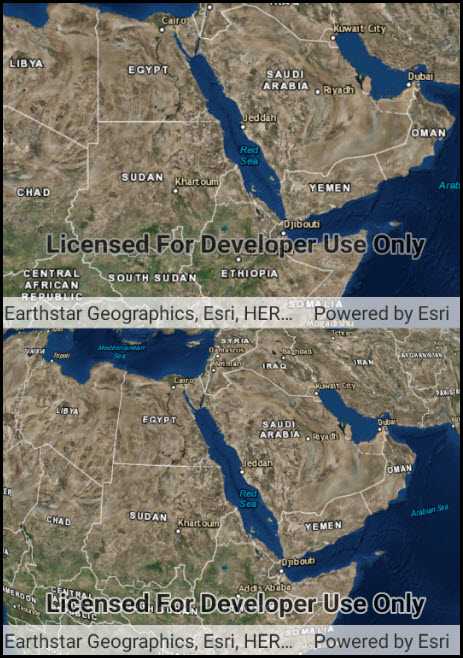Keep the view points of two views (e.g. MapView and SceneView) synchronized with each other.

Use case
You might need to synchronize GeoView viewpoints if you had two map views in one application - a main map and an inset. An inset map view could display all the layers at their full extent and contain a hollow rectangular graphic that represents the visible extent of the main map view. As you zoom or pan in the main map view, the extent graphic in the inset map would adjust accordingly.
How to use the sample
Interact with the MapView or SceneView by zooming or panning. The other MapView or SceneView will automatically focus on the same viewpoint.
How it works
- Wire up the
ViewpointChangedandNavigationCompletedevent handlers for both geo views. - In each event handler, get the current viewpoint from the geo view that is being interacted with and then set the viewpoint of the other geo view to the same value.
- Note: The reason for setting the viewpoints in multiple event handlers is to account for different types of interactions that can occur (ie. single tap pan -vs- continuous pan, single tap zoom in -vs- mouse scroll wheel zoom, etc.).
Relevant API
- GeoView
- GeoView.NavigationCompleted
- GeoView.ViewpointChanged
- GetCurrentViewPoint
- MapView
- SceneView
- SetViewPoint
About the data
This application provides two different perspectives of the Imagery basemap. A 2D MapView as well as a 3D SceneView, displayed side by side.
Tags
3D, automatic refresh, event, event handler, events, extent, interaction, interactions, pan, sync, synchronize, zoom
Sample Code
// Copyright 2017 Esri.
//
// Licensed under the Apache License, Version 2.0 (the "License"); you may not use this file except in compliance with the License.
// You may obtain a copy of the License at: http://www.apache.org/licenses/LICENSE-2.0
//
// Unless required by applicable law or agreed to in writing, software distributed under the License is distributed on an
// "AS IS" BASIS, WITHOUT WARRANTIES OR CONDITIONS OF ANY KIND, either express or implied. See the License for the specific
// language governing permissions and limitations under the License.
using Android.App;
using Android.OS;
using Android.Views;
using Esri.ArcGISRuntime.Mapping;
using Esri.ArcGISRuntime.UI;
using Esri.ArcGISRuntime.UI.Controls;
using System;
namespace ArcGISRuntime.Samples.GeoViewSync
{
[Activity (ConfigurationChanges=Android.Content.PM.ConfigChanges.Orientation | Android.Content.PM.ConfigChanges.ScreenSize)]
[ArcGISRuntime.Samples.Shared.Attributes.AndroidLayout("GeoViewSync.axml")]
[ArcGISRuntime.Samples.Shared.Attributes.Sample(
name: "GeoView viewpoint synchronization",
category: "SceneView",
description: "Keep the view points of two views (e.g. MapView and SceneView) synchronized with each other.",
instructions: "Interact with the MapView or SceneView by zooming or panning. The other MapView or SceneView will automatically focus on the same viewpoint.",
tags: new[] { "3D", "automatic refresh", "event", "event handler", "events", "extent", "interaction", "interactions", "pan", "sync", "synchronize", "zoom" })]
public class GeoViewSync : Activity
{
// Hold references to the GeoViews
private MapView _myMapView;
private SceneView _mySceneView;
protected override void OnCreate(Bundle bundle)
{
base.OnCreate(bundle);
Title = "GeoView viewpoint synchronization";
// Create the UI, setup the control references and execute initialization
CreateLayout();
Initialize();
}
private void Initialize()
{
// Initialize the MapView and SceneView with a basemap
_myMapView.Map = new Map(BasemapStyle.ArcGISImagery);
_mySceneView.Scene = new Scene(BasemapStyle.ArcGISImagery);
// Disable 'flick' gesture - this is the most straightforward way to prevent the 'flick'
// animation on one view from competing with user interaction on the other
_mySceneView.InteractionOptions = new SceneViewInteractionOptions { IsFlickEnabled = false };
_myMapView.InteractionOptions = new MapViewInteractionOptions { IsFlickEnabled = false };
// Subscribe to viewpoint change events for both views - event raised on click+drag
_myMapView.ViewpointChanged += OnViewpointChanged;
_mySceneView.ViewpointChanged += OnViewpointChanged;
// Subscribe to the navigation completed events - raised on flick
_myMapView.NavigationCompleted += OnNavigationComplete;
_mySceneView.NavigationCompleted += OnNavigationComplete;
}
private void OnNavigationComplete(object sender, EventArgs eventArgs)
{
// Get a reference to the MapView or SceneView that raised the event
GeoView sendingView = (GeoView)sender;
// Get a reference to the other view
GeoView otherView;
if (sendingView is MapView)
{
otherView = _mySceneView;
}
else
{
otherView = _myMapView;
}
// Update the viewpoint on the other view
otherView.SetViewpoint(sendingView.GetCurrentViewpoint(ViewpointType.CenterAndScale));
}
private void OnViewpointChanged(object sender, EventArgs e)
{
// Get the MapView or SceneView that sent the event
GeoView sendingView = (GeoView)sender;
// Only take action if this geoview is the one that the user is navigating.
// Viewpoint changed events are fired when SetViewpoint is called; This check prevents a feedback loop
if (sendingView.IsNavigating)
{
// If the MapView sent the event, update the SceneView's viewpoint
if (sender is MapView)
{
// Get the viewpoint
Viewpoint updateViewpoint = _myMapView.GetCurrentViewpoint(ViewpointType.CenterAndScale);
// Set the viewpoint
_mySceneView.SetViewpoint(updateViewpoint);
}
else // Else, update the MapView's viewpoint
{
// Get the viewpoint
Viewpoint updateViewpoint = _mySceneView.GetCurrentViewpoint(ViewpointType.CenterAndScale);
// Set the viewpoint
_myMapView.SetViewpoint(updateViewpoint);
}
}
}
private void CreateLayout()
{
// Show the layout in the app
SetContentView(Resource.Layout.GeoViewSync);
// Create the mapviews and sceneviews
_myMapView = FindViewById<MapView>(Resource.Id.GeoViewSync_MyMapView);
_mySceneView = FindViewById<SceneView>(Resource.Id.GeoViewSync_MySceneView);
}
protected override void OnDestroy()
{
base.OnDestroy();
// Remove the sceneview
(_mySceneView.Parent as ViewGroup).RemoveView(_mySceneView);
_mySceneView.Dispose();
_mySceneView = null;
}
}
}